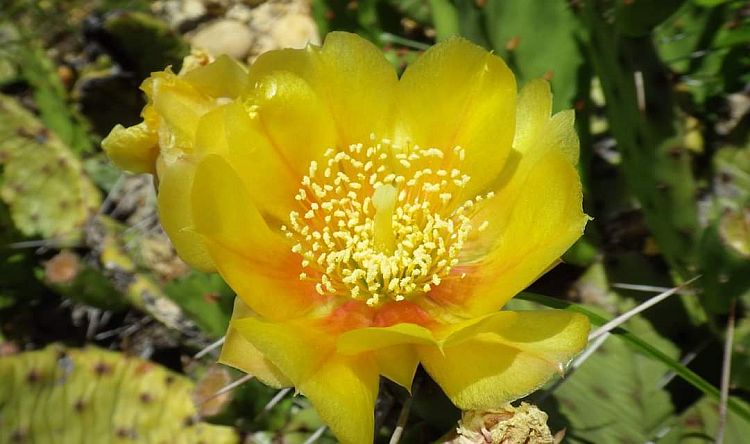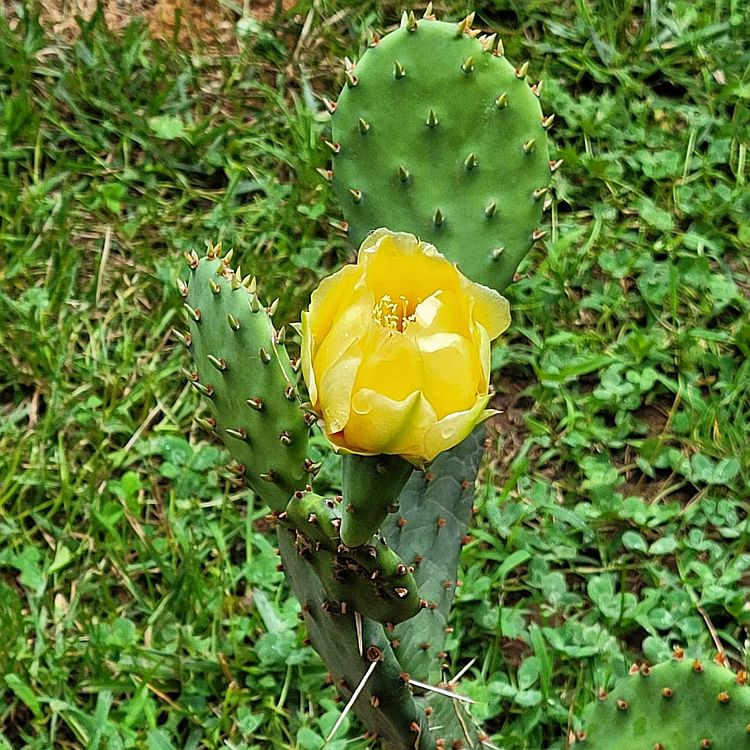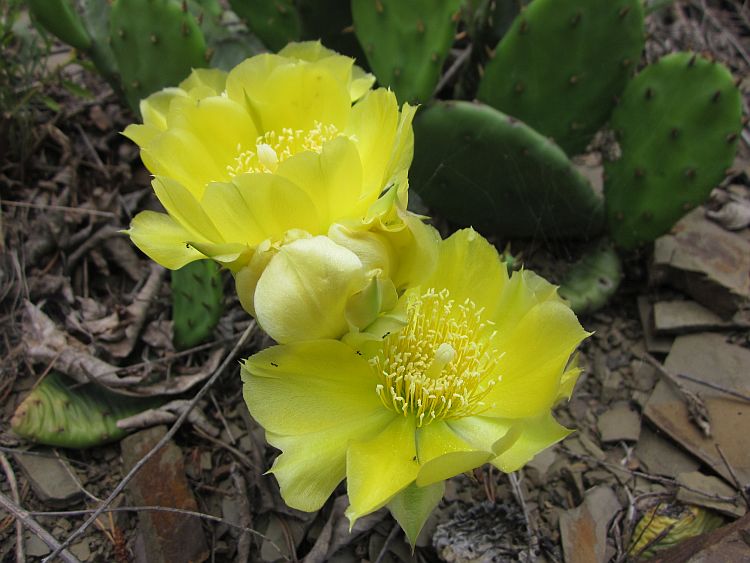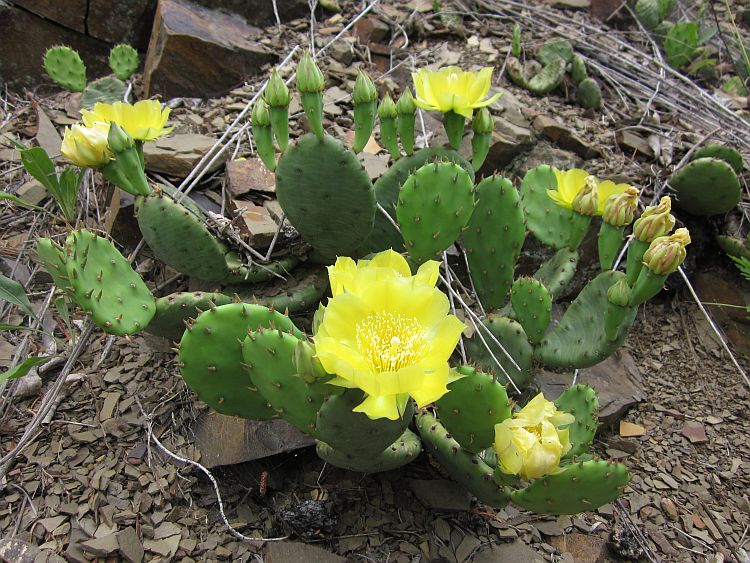My Discovery of the Eastern Prickly Pear
By Emily Byers, Jefferson Chapter
I enjoy the surprise of blooms in my garden each year and always add new native species. Last Fall, I received two eastern prickly pears, Opuntia humifusa, from a fellow gardener. I planted both cacti in a “problem” area of my garden. The area is shaded, gritty stays dry, and reminds me of a mini “Sahara.” In the past, anything planted there had shriveled and died. The addition of the spiny plant led to many other discoveries.
While taking a walk in July, I noticed a greenish-yellow round bud on the top of my eastern prickly pear. I watched in anticipation, waiting for that ultimate burst of color. I had seen patches of eastern prickly pears at Blandy State Arboretum but had never seen one in bloom. I was not disappointed when the bud burst open to display a bright yellow flower with seven sepals, one pistil, seven or more petals, and many stamens. The center was an orange hue and the petals were heart-shaped with a single point on each end. I had no idea that the cactus bloom would be so radiant and beautiful.

Prickly Pear (Opuntia cespitosa) along old railroad tracks in Alexandria, VA. Photo by R. H. Simmons
I was interested in learning more about the plant and began to research. For months there was no growth. I can only guess that it was establishing its root system. Winter came and my cacti retreated, turning wrinkly and slightly yellowed. I continued to worry that it would not survive the harsh winter temperatures and the snow. But in Spring, it came back to life and was once again bluish green with a matted waxy sheen. It grew taller and added new sessile pads.
The prickly pear pads have air pores called areoles that are arranged in a diagonal row pattern. Each areole has a small tuft of sharp bristles called glochids that develops a sharp spine. The thorns are deciduous, help to shade the cactus’s flesh, and help the cactus retain water. In discovering more about the plant, I found that the eastern prickly pear is in the Cactaceae family. The name is pronounced ō-pun′shi-a. The origin of the term Opuntia was coined by Pliny (AD 23-79) and it is thought that the name refers to the Greek town of “Opus where a cactus-like plant grew.” Humifusa is derived from a fusion of the Greek words “humus” meaning soil or earth and the word “fusus” meaning to spread. To remember the Latin name Opuntia, I visualize the pad of the cactus rounded like the ‘O’ with spines.
The cactus can grow up to two feet tall. The flowers can grow to be 2 to 3 inches wide and bloom from May to July. The flower is a golden yellow with a bright orange center. After the bloom is spent, it is replaced by an edible fruit full of seeds. The fruits are called cactus figs or tunas. The prickly pear genus originated in South America. The fruit is often eaten by small mammals that help to disperse the seed. The seeds were carried in the gut of small and large animals when the land was bridged between the two continents around three million years ago. The animals that spread the seed in their dung include deer, squirrel, rabbit, skunk, coyote, fox, turkey, and turtle.
Pollinators are attracted to the plant, particularly, native bees. Both long-tongued and short-tongued bees visit the flowers, including bumblebees, the large carpenter bee (Xylocopa virginica), digger bees (Melissodes spp.), leaf-cutting bees (Megachile spp.), halictid bees (including green metallic bees), and plasterer bees (Colletes spp.). Long-tongued bees suck nectar or collect pollen, while short-tongued bees collect pollen only; the larger bees are more likely to cause crosspollination.
An amazing adaptation of the eastern prickly pear was noted by Charles Darwin. He recognized that the cacti have thigmotactic anthers that curl over and deposit their pollen when touched. This movement can be seen by gently poking the anthers of an open Opuntia flower.
Historical literature shows that the plant was used in many ways. There are recipes for jellies, pickled cacti, candies, drinks, and more. The fruit’s taste is reminiscent of watermelon and the plant is rich in vitamin C and antioxidants that are an excellent source of energy for humans and wildlife.
A practical use for the plant includes the use of the spines as needles for sewing. The prickly pear has proven to be a favorite in my native garden as it is a treasure of ever-unfolding uses and beauty.
This article first appeared in the Spring 2023 edition of The Declaration, the newsletter of the Jefferson Chapter of the Virginia Native Plant Society.
Editors Note: A very detailed (65 pages) taxonomic review of Opuntia humifusa with extensive photos, structure, and distribution information is available at https://doi.org/10.11646/phytotaxa.290.1.1.




I found these growing wild in a clearing on a mountainside between Seneca Rocks and Petersburg. I had no idea these grew in WV. I made a big mistake and grabbed one of the pads and twisted it off – with my bare hands. Be careful. These had tiny needles – thousands of them – that weren’t apparent just by looking at them.
I brought some back (Marion Co. ) and my parents planted it in a pot on their porch. It lasted a few years, but was never thriving in the more humid atmosphere. I did get to eat some of the berries. I loved them.
I discovered these beautiful cactuses growing in my back yard on Maryland’s southern eastern shore. Being a Florida native I thought these were impossible to grow here. But our summer is hot dry and our soil is sand. What a wonderful gift from God!!